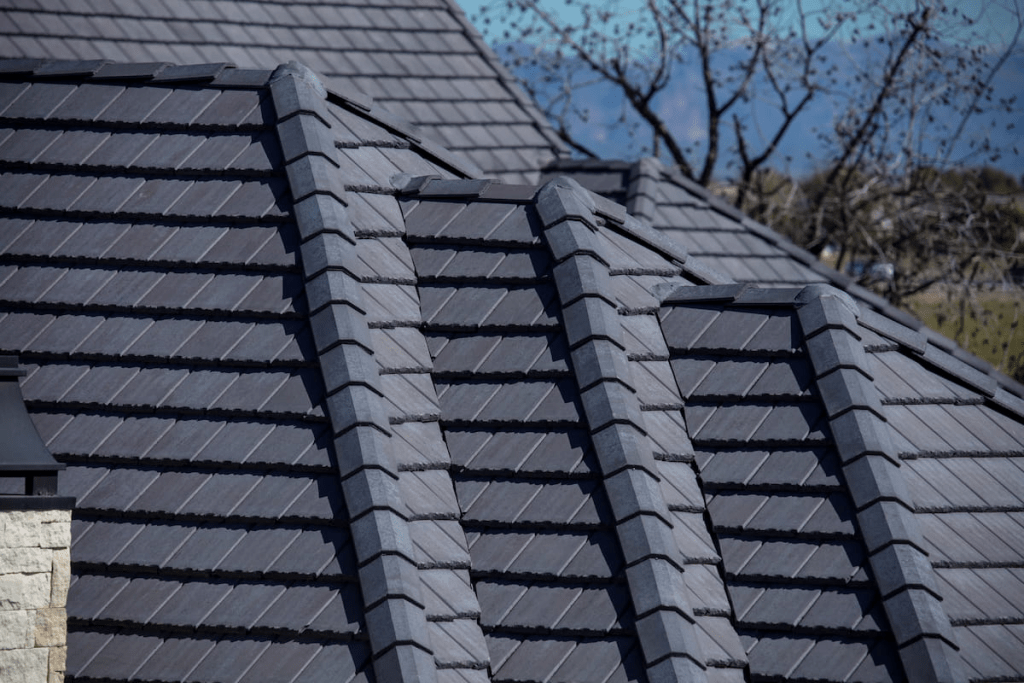When deciding on the perfect roofing material for your home, durability, aesthetics, cost, and maintenance are crucial factors to consider. Two of the most popular options, metal roofs and concrete tiles, have distinct advantages and drawbacks. This guide explores the differences between metal roof vs concrete tile to help you make an informed decision.

Why Choose Between Metal Roof and Concrete Tile?
The roof is a vital component of any structure, offering protection, insulation, and curb appeal. Selecting the right material ensures long-term performance while aligning with your aesthetic and budget preferences.
Read too: Hail Damage Roof Repair: Essential Guide to Restoring Your Home’s Protection
Advantages and Disadvantages of Metal Roof
Metal roofing has gained popularity for its modern appearance and exceptional performance in various climates. Here are its pros and cons:
Advantages
- Durability and Longevity
Metal roofs can last 40–70 years, resisting corrosion, cracking, and weather damage. - Energy Efficiency
Reflective coatings on metal roofs help reduce heat absorption, lowering cooling costs. - Lightweight
Metal roofs are significantly lighter than concrete tiles, reducing structural stress. - Ease of Installation
Metal sheets or panels are quicker to install compared to heavy tiles. - Sustainability
Metal roofing materials are often made from recycled content and are fully recyclable at the end of their lifespan.
Disadvantages
- Higher Initial Cost
Metal roofing has a higher upfront cost compared to asphalt shingles and some other options. - Noise During Rainfall
Metal roofs can amplify sound during rainstorms, although proper insulation mitigates this. - Denting and Scratching
While durable, metal roofs are prone to dents from hail or falling debris.
Advantages and Disadvantages of Concrete Tile
Concrete tiles have been used for centuries, renowned for their classic appearance and robustness. Here are their pros and cons:
Advantages
- Aesthetic Appeal
Concrete tiles offer a timeless look and come in a wide range of colors and designs. - Exceptional Durability
With proper maintenance, concrete tiles can last over 50 years and withstand harsh weather conditions. - Fire and Wind Resistance
Concrete tiles are non-combustible and perform well in high-wind environments. - Thermal Insulation
Concrete’s density provides excellent insulation, helping to regulate indoor temperatures.
Disadvantages
- Heavy Weight
Concrete tiles are much heavier than metal roofing, requiring reinforced structural support. - Higher Maintenance
Cracking and moss growth are common issues with concrete tiles, necessitating regular upkeep. - Costly Repairs
Replacing individual tiles can be labor-intensive and expensive.
Metal Roof Vs Concrete Tile: Key Comparisons
Durability
- Metal Roofs: Excellent resistance to corrosion, rust, and extreme weather. Lifespan of 40–70 years.
- Concrete Tiles: Outstanding durability with resistance to fire and high winds. Lifespan of 50+ years.
Cost
- Metal Roofs: Higher initial cost but lower maintenance expenses over time.
- Concrete Tiles: Moderate upfront cost, but the need for maintenance and repairs can increase overall expenses.
Weight
- Metal Roofs: Lightweight, requiring no additional structural support.
- Concrete Tiles: Heavy, often requiring reinforcement for proper installation.
Energy Efficiency
- Metal Roofs: Reflect heat, ideal for warm climates.
- Concrete Tiles: Provide insulation, suited for both hot and cold climates.
Aesthetic Options
- Metal Roofs: Sleek and modern; available in various finishes and colors.
- Concrete Tiles: Classic and versatile; mimic natural materials like clay or slate.
Metal Roof Vs Concrete Tile – Which Option Is Better for Your Home?
Your choice between metal roof vs concrete tile depends on your priorities, location, and budget.
Best for Durability
If longevity is your primary concern, both options deliver exceptional results. However, metal roofs are generally more resistant to wear and tear.
Best for Aesthetics
For those seeking a traditional, timeless appearance, concrete tiles are the better option. Metal roofs are perfect for modern or industrial-style homes.
Best for Energy Efficiency
Both materials offer energy-saving benefits, but metal roofs excel in hot climates due to their reflective properties.
Best for Budget
Consider the total cost of ownership, including installation, maintenance, and repairs. Metal roofs may have a higher initial investment but lower long-term costs.
Installation and Maintenance Considerations
Installation
- Metal Roofs: Faster and less labor-intensive.
- Concrete Tiles: Require skilled labor and reinforced structural support.
Maintenance
- Metal Roofs: Occasional cleaning and inspections are sufficient.
- Concrete Tiles: Regular maintenance to address moss, cracks, and potential leaks.
Sustainability and Environmental Impact
Both roofing options contribute to sustainable building practices. Metal roofs are recyclable, reducing waste, while concrete tiles are made from natural, abundant materials.
Making the Final Decision
Choosing between metal roof vs concrete tile requires careful consideration of your home’s specific needs, your budget, and your aesthetic preferences. Consulting with a professional roofing contractor can help you make the right choice.



Leave a Reply